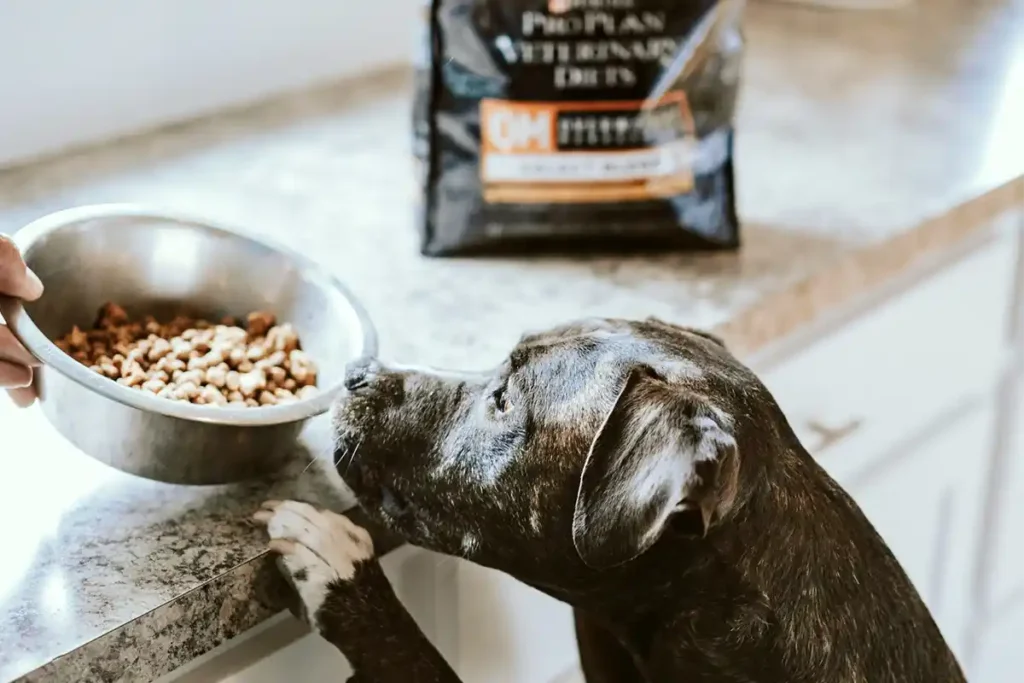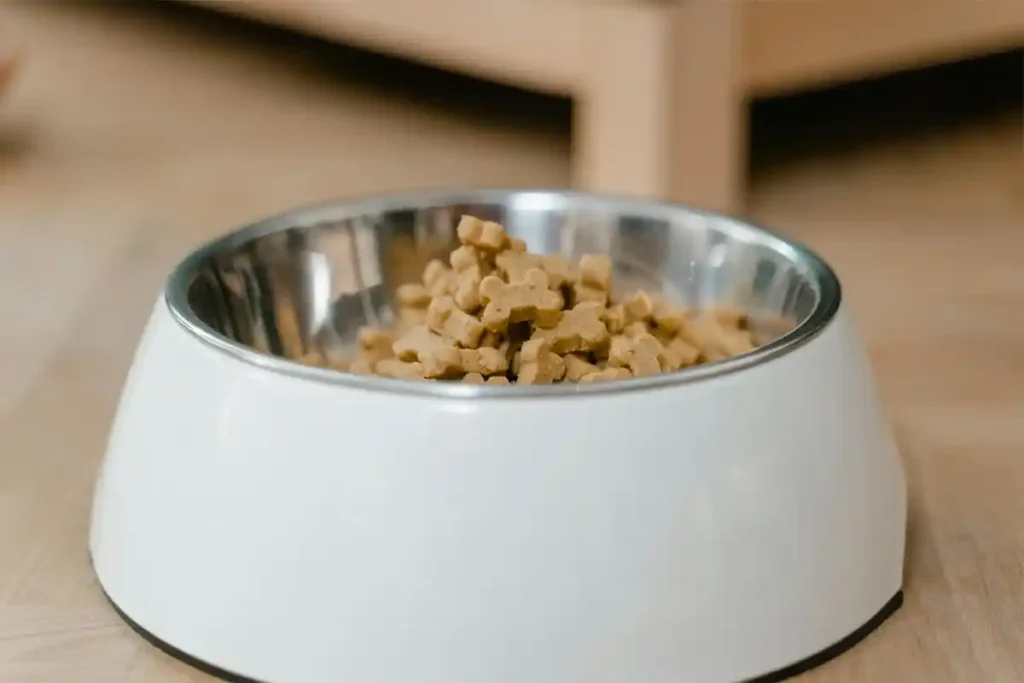Transitioning your puppy to adult dog food is a key milestone in their development. But navigating this change requires careful planning to ensure they receive the nutrition they need for a healthy life.
At Tailwaggors, we’re here to simplify this process for pet parents. With veterinary expertise, actionable steps, and research-backed advice, this guide will make the transition smooth and stress-free for both you and your pup.
Why This Matters
“Transitioning from puppy to adult food at the right time ensures your dog receives balanced nutrition to maintain their health and energy levels,” explains Dr. Esther Knoetze, BSc, BVSc. “Delaying this change can lead to unnecessary weight gain or nutritional imbalances.”
Did You Know?
According to a 2023 report by PetMD, over 40% of dog owners unknowingly continue feeding puppy food past the recommended age, increasing the risk of obesity and organ strain.

Why Transitioning from Puppy to Adult Dog Food is Essential
Your puppy’s dietary needs evolve as they grow. Puppy food, designed for rapid development, is rich in calories and nutrients. However, as your dog’s growth rate slows, excess nutrients can lead to health issues like obesity, kidney strain, or skeletal problems.
The Science Behind Puppy vs. Adult Dog Nutrition
- Protein Requirements: Puppies need 22–32% protein for growth, while adult dogs require 18–25% protein for maintenance.
- Calorie Needs: Puppy food is calorie-dense to fuel growth spurts, while adult food is lower in calories to prevent overfeeding.
- Balanced Nutrients: Adult formulas provide a precise balance of fats and carbohydrates to support long-term health.
Research Insight
A 2022 study in the Journal of Animal Nutrition revealed that dogs transitioned to adult food at the appropriate time were 30% less likely to develop obesity-related conditions.
Risks of Staying on Puppy Food Too Long
- Weight Gain: Overfeeding high-calorie puppy food can result in obesity.
- Nutritional Imbalance: Excess calcium and phosphorus may harm skeletal development, particularly in large breeds.
- Organ Strain: Prolonged intake of nutrient-dense food can stress the kidneys and liver.
Tailwaggors Tip
“Monitor your dog’s weight and energy levels. If they seem sluggish or are gaining weight rapidly, consult your veterinarian to reassess their diet.”
- Learn more in our 11 Warning Signs to Take Your Dog to the Vet article.

When to Transition Your Puppy to Adult Dog Food
Timing your puppy’s transition to adult food depends on their breed size and growth rate. Smaller breeds mature faster, while larger breeds need more time to develop fully.
Breed-Specific Guidelines
- Small Breeds (under 20 pounds/9 kg): Transition at 9–12 months.
- Medium Breeds (20–50 pounds/9–23 kg): Switch around 12 months.
- Large and Giant Breeds (50+ pounds/23+ kg): Transition between 12–18 months to accommodate their extended growth phase.
Did You Know?
A 2023 survey by Hill’s Pet Nutrition found that 78% of veterinarians recommend breed-specific timelines for food transitions to prevent growth-related health issues.
Behavioral and Physical Indicators
Not sure if your dog is ready for adult food? Look for these signs:
- Growth Stabilization: Your dog’s growth rate has slowed or stopped.
- Appetite Changes: Reduced interest in puppy food.
- Teeth Development: Adult teeth have fully replaced baby teeth.
Breed-Specific Puppy-to-Adult Food Transition Timeline
Small Breeds
Transition at 9–12 months. Examples: Chihuahua, Pug, Dachshund.
Medium Breeds
Transition at 12 months. Examples: Beagle, Cocker Spaniel, Border Collie.
Large & Giant Breeds
Transition at 12–18 months. Examples: Golden Retriever, Great Dane, Saint Bernard.
Veterinary Checkups
Regular veterinary visits are key to monitoring your dog’s growth and ensuring the timing is right. Vets can assess their weight, bone structure, and overall health to confirm when it’s time to make the switch.
- Learn about breed-specific care in Golden Retriever Breed Guide.

Step-by-Step Transition Timeline
Switching your puppy to adult food gradually minimizes the risk of digestive upset. A controlled approach over 7–10 days allows your dog’s stomach to adjust to the new formula while preventing food refusal or gastrointestinal distress.
Days 1–2: Start Mixing Puppy and Adult Food
- Combine 25% adult food with 75% puppy food for each meal.
- Monitor your dog’s stool consistency and appetite.
Pro Tip: “Introduce the new food during a calm period. Avoid starting transitions during stressful times like a move or after vaccinations,” advises Dr. Esther Knoetze.
Days 3–4: Adjust to a 50-50 Mix
- Increase the proportion of adult food to 50%, keeping the remaining 50% puppy food.
- Look for any signs of digestive upset, such as diarrhea or bloating.
Days 5–7: Transition to 75% Adult Food
- Shift to 75% adult food and 25% puppy food.
- By this stage, most dogs adapt well, but sensitive stomachs may need a slower progression.
Day 8–10: Complete the Transition
- Serve 100% adult food.
- Continue monitoring stool consistency and energy levels for at least a week to ensure no lingering issues.
Tailwaggors Tip
“If your dog experiences loose stools or refuses the new food, slow down the transition process and consult your vet if issues persist.”
Puppy Food Transition Tracker
Digestive Health Tips During Transition
- Hydration: Ensure your dog has access to plenty of fresh water to aid digestion.
- Supplements: Consider adding plain pumpkin or probiotics to soothe the stomach.
- Pause if Needed: If symptoms like diarrhea persist, revert to the previous step and allow more time for adjustment.
Did You Know?
A study by Hill’s Pet Nutrition found that gradual transitions over 10 days reduce gastrointestinal issues by 75% compared to abrupt food changes.
- Explore structured feeding strategies in our guide, Essential Dog Training Commands.
7-Day Puppy-to-Adult Food Transition Guide
Day 1–2
75% Puppy Food
25% Adult Food
Day 3–4
50% Puppy Food
50% Adult Food
Day 5–6
25% Puppy Food
75% Adult Food
Day 7
100% Adult Food

Common Challenges During the Food Transition
Transitioning your dog to adult food isn’t always smooth. Digestive issues, picky eating habits, and outright refusals are common challenges, but with the right approach, they can be overcome.
Digestive Upsets: Causes and Solutions
Digestive upset is one of the most frequent issues during transitions. Symptoms like diarrhea, gas, or vomiting often occur when changes are made too quickly.
Why It Happens:
Switching foods abruptly disrupts the delicate balance of gut bacteria, leading to gastrointestinal distress.
Solutions:
- Slow the Transition: Follow the 7–10 day timeline to allow your dog’s digestive system to adjust.
- Hydration is Key: Ensure your dog has access to plenty of fresh water.
- Supplement with Pumpkin: Add plain, unsweetened pumpkin to meals to soothe an upset stomach.
Pro Tip:
“If symptoms persist for more than 48 hours, consult your veterinarian to rule out allergies or other underlying conditions,” advises Dr. Esther Knoetze.
Did You Know?
According to PetMD, following a gradual transition plan can reduce the likelihood of diarrhea by up to 50%.
Encouraging Picky Eaters
Some dogs are resistant to new food due to unfamiliar smells, textures, or tastes. Patience and creative strategies can help.
Tips for Picky Eaters:
- Enhance Flavor: Warm the food slightly or add a splash of low-sodium chicken broth to enhance aroma and taste.
- Mix Textures: Combine wet and dry food to provide variety.
- Establish Consistency: Feed at the same times daily to build a routine.
Real-World Example:
“One of my clients, a Shih Tzu owner, successfully transitioned their dog by adding a small amount of wet food to dry kibble for flavor. Within a week, the dog fully accepted the new food,” shares Dr. Esther Knoetze.
Managing Refusals
If your dog outright refuses to eat the new food:
- Start Slower: Reduce the percentage of adult food in the mix.
- Reward Positive Behavior: Praise or reward your dog when they eat even a small portion of the new food.
- Switch Blends: If refusals persist, consult your vet to explore alternative adult food options.
Interactive Suggestion:
Picky Eater Troubleshooting Chart
| Issue | Possible Cause | Solution |
|---|---|---|
| Sniffs food but won’t eat | Unfamiliar smell or taste | Warm the food slightly to enhance aroma. Add a splash of low-sodium chicken broth for flavor. |
| Eats a little but leaves the rest | Overfeeding or too many treats | Adjust portion sizes and reduce treat intake. Stick to a feeding schedule. |
| Refuses food completely | Stress or anxiety | Create a calm feeding environment. Avoid major changes during stressful times. |
| Vomits after eating | Eating too quickly | Use a slow feeder bowl to pace eating. Monitor and consult your vet if the issue persists. |
Tailwaggors Tip:
“Avoid giving excessive treats during transitions, as this can reduce your dog’s appetite for regular meals.”
Common Behavioral Changes During Transition
Changes in diet can sometimes lead to temporary behavioral shifts, such as:
- Irritability: Monitor for signs of restlessness or aggression.
- Reduced Activity: A drop in energy levels may signal digestive discomfort or inadequate nutrition.
Solution: Ensure mental stimulation through playtime and consistent routines to keep your dog engaged and reduce stress.
- Check out our guide on 9 Simple Ways to Make Your Dogs Happy for enrichment ideas.
Did You Know?
A study by AKC found that dogs with structured mealtimes adapt to food transitions 30% faster than those with irregular schedules.

Choosing the Best Adult Dog Food for Your Puppy
Selecting the right adult dog food is crucial for ensuring your dog receives the proper nutrition to maintain their health and energy. With countless options available, understanding what to look for on labels and what to avoid is key.
When choosing a dog food brand, prioritize quality over marketing. Vet-recommended brands adhere to rigorous testing standards, while boutique brands may lack comprehensive nutritional research.
Checklist for Selecting Food:
- AAFCO Standards: Look for labels indicating “Complete and Balanced” nutrition for adult dogs.
- Named Protein Sources: Ensure the first ingredient is a named protein like chicken, beef, or salmon, not “meat meal” or by-products.
- Avoid Harmful Additives: Steer clear of artificial colors, flavors, and preservatives.
Expert Insight:
“While boutique brands often market trendy ingredients, they may not meet the complete nutritional needs of your dog. Always consult your vet before making changes,” advises Dr. Esther Knoetze.
Did You Know?
According to a 2023 report by AAFCO, nearly 60% of boutique dog foods tested lacked adequate nutrient balance for long-term health.
Understanding Dog Food Labels
Navigating dog food labels can feel overwhelming, but decoding them is essential for ensuring your dog gets the nutrition they need. Here’s how to break down the key elements and make an informed decision:
1. Guaranteed Analysis
The guaranteed analysis provides insight into the nutrient content of the food. Look for:
- Protein Levels: Adult dogs typically need 18–25% protein for muscle maintenance.
- Fat Content: Aim for 10–15% fat, providing energy without excess calories.
- Fiber: A range of 2–5% fiber supports healthy digestion.
Pro Tip: Ensure the guaranteed analysis meets the minimum nutritional needs recommended by the AAFCO for adult dogs.
2. Ingredient List
Ingredients are listed in descending order by weight, with the heaviest listed first. Key considerations:
- Whole Proteins First: High-quality foods list ingredients like “chicken” or “beef” as the first ingredient, not “meat meal” or “by-products.”
- Avoid Fillers: Skip products with excessive fillers like corn or soy as primary ingredients.
- Additives and Preservatives: Avoid artificial colors, flavors, or chemical preservatives like BHA or BHT.
Did You Know?
A 2023 study found that dogs fed diets with whole proteins as the primary ingredient had 20% better overall health outcomes compared to those on filler-heavy diets.
3. Life Stage Statement
The life stage statement indicates whether the food is formulated for specific stages of your dog’s life. Look for:
- “Adult Maintenance”: This ensures the food meets the calorie and protein needs of adult dogs.
- “All Life Stages”: Suitable for puppies and adults but often calorie-dense, which can lead to overfeeding in adult dogs.
Pro Tip: Transition to a food labeled specifically for “adult maintenance” to help prevent weight gain as your puppy matures.
Additional Tips for Label Reading
- Calories per Cup: Compare the calorie content to your dog’s activity level and portion accordingly.
- Nutritional Adequacy Statement: Ensure the label states compliance with AAFCO guidelines, which guarantee the food provides complete and balanced nutrition.
- Feeding Directions: Use the feeding guide on the label as a starting point, but adjust portions based on your dog’s unique needs.
Tailwaggors Tip
“If the label feels too complicated or unclear, consult your veterinarian to ensure the food aligns with your dog’s health and nutritional requirements.”
Dog Food Label Decoder Tool
Click on any part of the label to learn what it means and why it’s important for your dog’s health.
Guaranteed Analysis
Ingredient List
Life Stage Statement
Grain-Free vs. Grain-Inclusive Diets
The grain-free trend has raised questions among pet parents. While grain-free diets may benefit dogs with specific allergies, they are not necessary for most dogs.
Research Insight:
A 2023 study by the FDA found a potential link between grain-free diets and dilated cardiomyopathy (DCM) in certain breeds. Consult your vet before making this switch.
Pro Tip:
“Grain-inclusive diets often provide better heart health benefits unless your dog has a confirmed grain sensitivity,” notes Dr. Knoetze.
Portion Control and Feeding Guidelines
The amount of food your dog needs depends on their weight, activity level, and breed. Use the feeding chart on the food label as a starting point but adjust based on your dog’s individual needs.
Tailwaggors Tip:
“Measure your dog’s food with a standard measuring cup to avoid overfeeding, which is a leading cause of obesity in adult dogs.”
- Explore our article, CBD Oil: Unlocking Serenity or Not? to learn about supplements that can enhance your dog’s diet.
Picky Eater Troubleshooting Chart
| Issue | Possible Cause | Solution |
|---|---|---|
| Sniffs food but won’t eat | Unfamiliar smell or taste | Warm the food slightly to enhance aroma. Add a splash of low-sodium chicken broth for flavor. |
| Eats a little but leaves the rest | Overfeeding or too many treats | Adjust portion sizes and reduce treat intake. Stick to a feeding schedule. |
| Refuses food completely | Stress or anxiety | Create a calm feeding environment. Avoid major changes during stressful times. |
| Vomits after eating | Eating too quickly | Use a slow feeder bowl to pace eating. Monitor and consult your vet if the issue persists. |

FAQs About Transitioning Puppy to Adult Dog Food
Pet parents often have lingering questions during the transition from puppy to adult food. Here are detailed answers to the most common concerns:
What happens if I switch too quickly?
Q: What happens if I switch my dog’s food too quickly?
A: Abrupt changes can disrupt your dog’s digestive system, leading to symptoms like diarrhea, gas, or vomiting. Gradually transitioning over 7–10 days minimizes the risk of gastrointestinal upset. If issues persist beyond 48 hours, consult your veterinarian.
Did You Know?
Studies show that gradual transitions reduce the likelihood of digestive problems by 75% (Hill’s Pet Nutrition, 2023).
Can I transition without mixing old and new food?
Q: Is it possible to transition my dog without mixing their old and new food?
A: While mixing is the best approach, transitioning without it is possible for dogs with no prior food sensitivities. However, start with very small portions of the new food and monitor your dog for any signs of discomfort.
What should I do if my dog has diarrhea during the transition?
Q: How should I handle diarrhea during a food transition?
A:
- Reduce the proportion of new food in the mix.
- Add a spoonful of plain, unsweetened pumpkin to meals to soothe the stomach.
- Pause the transition temporarily and consult your vet if diarrhea persists beyond 48 hours.
Tailwaggors Tip:
“Never introduce additional treats or table scraps during a transition, as they can exacerbate digestive upset.”
How much food should I feed my dog after transitioning?
Q: What is the correct portion size for adult food?
A: Portion sizes vary based on your dog’s breed, weight, and activity level. Use the feeding chart on the dog food label as a guide, but adjust as needed to maintain a healthy weight.
Interactive Suggestion:
Include a Portion Calculator Tool where users can input their dog’s weight and activity level to get a customized feeding recommendation.
Are grain-free diets better for adult dogs?
Q: Should I choose a grain-free diet for my adult dog?
A: Grain-free diets are not inherently better unless your dog has a specific grain allergy. In fact, grain-inclusive diets often provide essential nutrients for heart health. Consult your vet before switching to a grain-free formula.
Research Insight:
The FDA reported a potential link between grain-free diets and dilated cardiomyopathy (DCM) in certain breeds.
What if my dog has food allergies?
Q: How do I manage food allergies during a transition?
A:
- Switch to a limited-ingredient or hypoallergenic diet.
- Monitor for signs like itching, ear infections, or excessive licking.
- Consult your vet for an allergy test to confirm the trigger ingredient.
Can I transition to homemade food instead of commercial adult dog food?
Q: Is homemade food a good alternative to adult dog food?
A: Homemade diets are an option, but they require precise nutrient balancing to meet your dog’s needs. Work with a veterinary nutritionist to ensure the diet aligns with AAFCO standards.
How do I know my dog is ready for adult food?
Q: What signs indicate it’s time to transition to adult food?
A: Look for these indicators:
- Slower growth rate or weight stabilization.
- Reduced interest in puppy food.
- Full development of adult teeth.
- Explore our article, How to Help Your Dog and Cat Coexist, for tips on managing diet transitions in multi-pet households.
Additional Resources for Pet Parents
Transitioning your puppy to adult food is an essential milestone, but it’s just one part of their health journey. At Tailwaggors, we provide resources to guide you through every stage of pet parenting, ensuring your furry friend thrives.
Keeping Your Dog Healthy During Life Stages
Your dog’s nutritional needs change as they grow. Regular veterinary checkups and an age-appropriate diet are essential for maintaining their health.
Expert Insight
“Transitioning from puppy to adult food is just the beginning. As your dog ages, they may require senior food with adjusted nutrient levels to support joint health and energy,” explains Dr. Esther Knoetze, BSc, BVSc.
- Learn more about maintaining your pet’s health in our guide, Why Regular Checkups Are Important to Your Pet’s Health.
Managing Behavioral Challenges During Transitions
Food changes can sometimes trigger behavioral shifts, such as anxiety or decreased appetite. Addressing these challenges early ensures a smoother transition for both you and your dog.
Practical Tip:
- Stick to consistent feeding times and ensure your dog gets adequate exercise to reduce stress during transitions.
- Introduce calming routines, like gentle grooming or quiet play sessions, to ease their anxiety.
Read our guide on Understanding Separation Anxiety in Dogs.
Resources for New Pet Parents
If you’re a first-time dog owner, getting started with the right knowledge and tools is critical to creating a strong foundation for your pet’s well-being.
- Check out our article, 10 Things to Consider Before Bringing a New Pet Home.

Conclusion: A Smooth Transition for a Healthier Dog
Transitioning your puppy to adult food is more than just a dietary change—it’s a step toward ensuring their long-term health and happiness. By following a gradual timeline, monitoring their progress, and choosing high-quality food, you’re setting your dog up for a vibrant and healthy adulthood.
At Tailwaggors, we’re committed to supporting pet parents every step of the way. From practical feeding tips to managing behavioral changes, our resources empower you to make informed decisions for your furry friend.
Transitioning your puppy to adult dog food is a critical step for their health and happiness! 🐾✨
🎉 Discover expert tips, step-by-step guidance, and solutions for common challenges in this must-read guide.
Share with your fellow dog lovers and help every pup thrive! 🐶❤️











